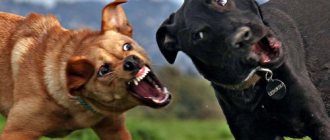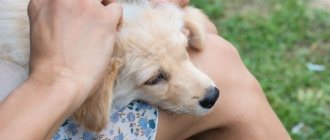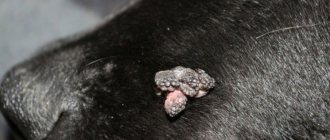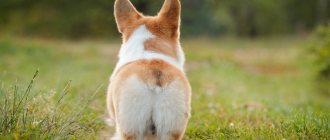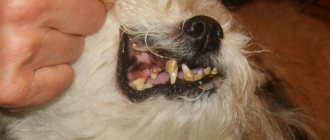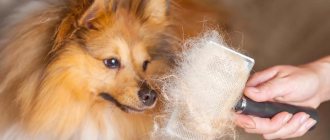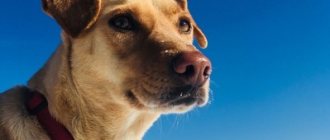Aggression in dogs is a fairly pressing issue in modern society, which affects not only stray dogs, but also domestic ones. If we look at the statistics, about 65% of those bitten by a four-legged pet are children and the elderly. This problem is very serious and widespread regardless of the territory and size of the settlement.
The main causes of aggression in dogs
There is nothing wrong with aggression as such. This is an instinct that helps animals protect themselves, territory and offspring.
In some breeds, anger is more pronounced. These include service, guard, fighting and hunting dogs. In such pets, aggression towards strangers and suspicious people is deliberately caused and trained.
But in any case, the dog’s behavior must be controlled. He can be angry when needed. And under no circumstances should you rush at the owner, household members, other dogs, pets or passers-by.
Another thing is unmotivated, unwanted aggression. It develops due to:
- violations of selection rules
- when animals are thoughtlessly crossed without taking into account breed and genetic characteristics and the result is a dog with unpredictable behavior;- poor maintenance
- insufficient nutrition, constant stay in an enclosure or on a leash negatively affect the psyche;- improper upbringing
- lack of socialization, training, established rules of behavior.
A lack of upbringing also includes permissiveness, when the owner indulges all the whims of the pet and automatically takes a lower place on the hierarchical ladder.
Sometimes systemic pathologies become the causes of sudden aggression. The dog is in pain, and she transfers her anger to those around her.
It is important to understand that behavioral problems in dogs develop due to the fault of the owner. Only in 1% of cases can aggression be conditionally attributed to genetic and congenital mental abnormalities.
Contact your veterinarian
Dogs that are not normally aggressive but suddenly show aggressive behavior may have a serious health problem.
Health problems that can cause aggression include hypothyroidism, painful injuries, and neurological problems such as encephalitis, epilepsy, and brain tumors.
Talk to your veterinarian to determine if this is the case for your dog. Treatment or medication can significantly improve your dog's behavior.
How to identify bitterness
Aggression in dogs is easily detected by external signs. They differ depending on the degree of anger:
- At the initial stage,
the dog humps his back a little, pinches his tail between his paws, bares his teeth, and flattens his ears. There is no need to be afraid of such behavior - it is just a threat. If you do not provoke the animal, do not turn your back to it and do not run away, it will not attack. - With a medium form
, folds will appear on the forehead, the hair will stand on end, and the dog will look into the eyes. - Severe aggression,
in addition to initial and moderate signs, is manifested by redness of the eyes, a high tail, intermittent breathing, and sometimes uncontrolled urination. It is no longer possible to “agree” with the dog; it is worth isolating it if possible and doing everything to protect yourself.
Create a plan
A dog trainer or trainer can help you find the best way to deal with your dog's aggression. In most cases, you will use positive reinforcement to teach your dog new behaviors.
For example, if your dog is mildly aggressive towards strangers, start by moving away from someone your dog doesn't know.
You need to be far enough away that your dog won't growl or snap his teeth. Then reward with lots of treats and praise, gradually decreasing the distance between the dog and the stranger while continuing to use positive reinforcement.
Ideally, your dog will begin to understand that strangers are equal to treats, and you will notice a decrease in his aggression. This same procedure can help your dog become accustomed to a variety of other situations.
General Remedies
There are no universal ways to wean a dog from aggression. The owner needs to look for an individual approach in each case, and together with the dog handler.
But there are general tips for correcting behavior:
- identify why anger arose and eliminate its source;
- exclude possible diseases;
- do not beat, humiliate, punish or yell at your pet;
- establish leadership;
- encourage kindness and obedience.
Children should be taught the rules of behavior around animals as early as possible. They must treat the dogs kindly and approach and pet them only with the permission of adults.
Separately, there are medicinal methods that can help remove aggression.
The first is taking sedatives. They relieve increased excitability and anxiety, and facilitate behavior correction.
The second includes castration. The method is used when a dog shows competitive, social, or sexual aggression. Moreover, the method works better with male dogs - their androgen levels drop after surgery.
In bitches, the level of hormones remains almost unchanged, so sterilization is effective only during estrus or false pregnancy.
Nutrition
Special attention is also paid to feeding, since it is this that influences the formation and development of the puppy.
The health of the animal depends on the quality and quantity of products. With proper nutrition and proper care, Doberman Pinschers will live a long, quality life. Aristocratic dogs are absolutely not picky about food. Both dry food and natural products are perfect for them. The Doberman dog respects meat. However, it must be taken into account that its share in the diet should not exceed 40 percent. As a rule, meat is combined with various cereals, fermented milk products, and vegetables.
As for the type of meat, it is better to avoid pork and minced meat. Don't forget about foods that are rich in fiber. The Doberman's diet must include rice, buckwheat, and millet.
Several times a week, meat is replaced with fish. The following products are prohibited:
- Cutlets.
- Sausage.
- Sausages.
- Sugar.
- Potato.
All of the above products can cause gastritis and ulcers.
As for approaches to the plate, a single meal is sufficient for an adult animal, however, an acceptable option is feeding in the morning and at lunch.
According to experts, babies up to 6 months need to be fed 5-6 times a day. With age, intake is reduced to 4 times. Required condition! A nursing animal, like any other, should not be left without water. The water must be changed 2 times a day.
Types of aggression and ways to correct them
There are 10 main types of behavior caused by anger. Each of them has characteristic features and requires special correction methods.
Dominant
It appears during puberty and social maturation - at 1.5 - 3 years. More typical for males. Only 10% of bitches exhibit it. A characteristic sign is that the dog becomes even more embittered when punished.
How to prevent and correct:
- establish a clear hierarchy in the family, in which the dog will take last place;
- determine the rules of behavior for the dog and strictly adhere to them;
- prohibit the pet from sleeping on the bed or eating from the table;
- ensure that the animal obeys the first time, or at most the second time.
Food
Easily identified by the following characteristics:
- when eating, the dog bares its teeth at suitable dogs, cats, people;
- bites when trying to pick up a bowl;
- at the same time growls and greedily swallows food, and may drop it;
- Sometimes attacks of food aggression occur if the dog receives a special treat.
It develops quite often due to indulgence in food habits: feeding from the table, frequent undeserved treats, encouragement of begging. Also, food aggression appears if the animal eats before or at the same time as family members.
How to wean:
- before feeding, give the command “sit”;
- place the bowl in front of the dog and command “wait”;
- pause and allow eating with the command “may”;
- interrupt the meal with the commands “fu”, “no”, “wait”, wait a little and allow eating again;
- repeat several times.
Breeders' fault.
I believe that the breeders who supply a new generation of puppies to the market every six months are primarily to blame.
Of course, among them there are real professionals who take their work or hobby seriously and responsibly. Seriously, this means that they monitor all cases of the appearance of puppies with such heredity and, at a minimum, do not sell them to inexperienced people, but experienced people are warned about the level of dominance of the puppy, and, at maximum, such puppies are euthanized. This is the other (dark) side of this profession.
Unfortunately, most breeders breed their bitches with only one goal in mind – making a profit. Their task is to get as many offspring as possible from a female of the currently popular breed. She gave birth to seven puppies - all seven will be sold, she gave birth to twelve puppies - great, the profit will be even greater. After all, you need to “seize” the moment! Soon there will be many dogs of this breed and it will cease to be fashionable.
Therefore, a lot of dogs of two extreme, obviously problematic psychophysiological types appear on the market every year - dominant
and cowardly
(not dominant).
The problem of hidden evidence.
The author of this term, mathematician, philosopher and successful trader, Nassim Nicholas Taleb.
In his magnificent book “The Black Swan”, he, citing Cicero, gives the following story.
“The Greek philosopher Diagoras, nicknamed the Atheist, was shown images of people who prayed to the gods and were saved from a shipwreck. It was understood that prayer saves from death. Diagoras asked: “Where are the images of those who prayed, but still drowned?” It is not so easy for pious drowned men to express their opinions from the bottom of the sea for the reason that they are dead.”
Next, he cites the opinion of Michel de Montaigne and Francis Bacon, who saw in this story an example of the origin of all superstitions. In particular, Bacon wrote: “This is the basis of almost all superstitions - in astrology, in dreams, in superstitions, in predictions and the like.”
The book is wonderful and I recommend reading it to everyone who wants to understand the nature and role of chance in our lives.
I hope that you understand that by quoting these excerpts from Nassim Taleb’s book “Black Swan”, I want to say that belief in “dogs that unconditionally love people” is akin to the superstition of our days. And that by starting a conversation about aggressive dogs, we touch on the problem of hidden evidence - we do not know how many dogs actually attack people, because their owners prefer to remain silent, feeling condemned by society.
If dogs with hereditary aggression regularly appear, and the owner is not really to blame for this, then who is to blame for this? Let's figure it out.
Whose blood flows?
The Doberman Pinscher is a relatively young breed.
It arose as a result of crossing many breeds, including the German, French Shepherd, English Greyhound and German Pinscher. The father of this breed is the German tax inspector Louis Dobermann. The dog's appearance shows the features of a miniature pinscher, however, in terms of strength and size, it is a full-fledged guard dog. Unfortunately, the breeder did not leave any records about the breed, so modern experts can only speculate and speculate about their origin. It is worth noting that the Doberman Pinscher is the only representative of the German breed that received the name of its owner. There is a legend that Doberman specifically bred this watchdog for his own protection. This dog's introduction to the world occurred in 1876. They appeared in Russia at the beginning of the 20th century. Immediately after their appearance, dogs began to be widely used for search purposes. In the middle of the 20th century, this breed acquired official status by the International Cynological Association.
Modern Dobermans are individuals of the highest class, which have repeatedly become prize-winners of international exhibitions.
Doberman breed description - briefly
The breed standard is characterized by the following qualities:
- Color ranges from black to yellow-brown.
- There are also chocolate-colored dogs.
- The size of males at the withers is 68-72 cm, females - 63-68 cm.
- The ideal option is when the length of the body is proportional to the height.
- A male weighs 40-45 kg, a female from 32 to 35 kg.
- Life expectancy is 11 years.
- Country of origin: Germany.
- Where is it used? Army, police. They often play the role of devoted friends and family members.
final grade
Well, it’s time to summarize and give a general assessment of this animal. So, the assessment takes place according to a 10-point system.
Doberman characteristics are as follows:
- Hostility is 6 out of 10.
- Adaptability 8.
- Activity 10.
- Playfulness, friendliness 8 out of 10.
- Intellectual abilities 6.
- Training 10 out of 10.
So, the overall score is 8 points, which characterizes the dog on the positive side. The love and devotion that comes from the kind heart of a Doberman is beyond the power of years.
